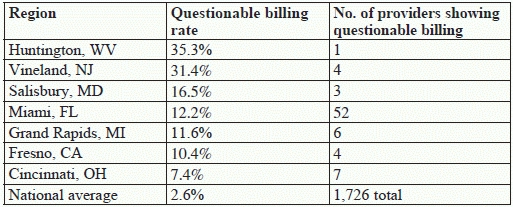Ophthalmology Providers in WV, NJ Logged High Error Rates

OIG report shines spotlight on questionable billing for wet AMD, cataract surgery.
Most practices are aware of the fact that the OIG looks for questionable billing trends, and the agency’s recent review of ophthalmology services was no different—in fact, the OIG even drilled down to look for geographic trends, and found that providers in West Virginia and New Jersey had the highest error rates.
Background: The OIG evaluated whether ophthalmology services are vulnerable to fraud, waste and abuse after noting that ophthalmologists collected $6.7 billion for wet age-related macular degeneration (wet AMD) and cataracts in 2012 alone. As part of the study, which was published last week under the name “Questionable Billing for Medicare Ophthalmology Services,” the feds examined 34 million paid claims and determined whether they were billed accurately.
The findings: The OIG found that most ophthalmology practices maintained appropriate coding and billing practices, with only four percent of audited practices demonstrating “questionable billing” habits.
Watch Lucentis Frequency
When it came to wet AMD treatments, the OIG found a high error rate among practices administering Lucentis injections. The majority of inappropriate billing practices were seen when Lucentis injections were performed more often than 28 days per eye. Providers who administer these injections more frequently than every 28 days raise questions about the medical necessity of the services, the OIG said. The agency also found several ophthalmologists who administered more than 12 or 13 Lucentis injections per calendar year.
The OIG also discovered about $39 million in questionable billing practices for complex cataract surgeries, and some providers were more suspicious than others. “For most providers, complex cataract surgery comprised less than two percent of their claims for cataract surgery,” the report said. “However, one provider billed for almost all of his cataract surgeries (356 out of 369) as complex,” the OIG added.
Needless to say, if that particular doctor specialized in high-complexity cataract operations, it’s possible that his billing was justified. However, the OIG certainly marked him as an outlier and will be sure to investigate further.
Check out Geographic Trends
Interestingly, the OIG found that seven specific U.S. regions logged questionable ophthalmology billing habits at twice the rate of the rest of the country. Keeping in mind that the OIG marked 2.6 percent as an average questionable billing rate in the country based on its audit, it’s interesting to note that the following metropolitan areas saw significantly higher error rates:
Expect Further Scrutiny
Going forward, eye care practices should keep all billing habits buttoned up, since the OIG has advised CMS to “increase monitoring of billing for ophthalmology services…and review and take appropriate action regarding providers with questionable billing,” the report notes. In other words, CMS will be more vigilant than ever in looking for these errors, so any mistakes will be scrutinized.
Resource: To read the complete OIG report, visit http://go.usa.gov/3ePEx.




